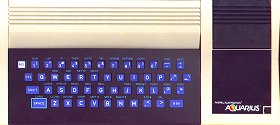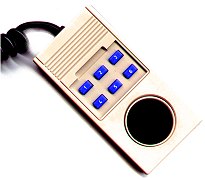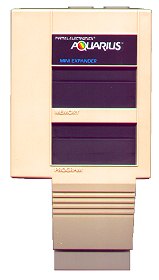Was it a video game console…or a home computer?
 In the sad case of Mattel’s Aquarius, the company putting it on the market simply didn’t seem to know. And of all the failed attempts of the early 1980s video game manufacturers to turn their game machines into computers, Aquarius was one of the most humbling fumbles of the entire era.
In the sad case of Mattel’s Aquarius, the company putting it on the market simply didn’t seem to know. And of all the failed attempts of the early 1980s video game manufacturers to turn their game machines into computers, Aquarius was one of the most humbling fumbles of the entire era.
 The brainchild of Hong Kong-based Radofin Electronics, Aquarius seemed – at least from its outward design aesthetic – to be a study in what would happen if Mattel’s Intellivision and the My First Computer keyboard module Atari touted for the VCS had a kid. The master console itself was attractive enough, with blue rubber keys on a black-and-white casing; at a distance, the Aquarius almost looks like a slight variation on the TI 99/4A with its horizontal cartridge/expansion slot to the right of the keyboard. The “Mini-Expander Module” was needed to play games on the Aquarius, consisting of an extension to the cartridge slot and two detachable Intellivision-style controllers (though smaller, smoother and easier to hold), each with the standard “joy-disc” and a six-button keypad (as opposed to its predecessor’s twelve keys).
The brainchild of Hong Kong-based Radofin Electronics, Aquarius seemed – at least from its outward design aesthetic – to be a study in what would happen if Mattel’s Intellivision and the My First Computer keyboard module Atari touted for the VCS had a kid. The master console itself was attractive enough, with blue rubber keys on a black-and-white casing; at a distance, the Aquarius almost looks like a slight variation on the TI 99/4A with its horizontal cartridge/expansion slot to the right of the keyboard. The “Mini-Expander Module” was needed to play games on the Aquarius, consisting of an extension to the cartridge slot and two detachable Intellivision-style controllers (though smaller, smoother and easier to hold), each with the standard “joy-disc” and a six-button keypad (as opposed to its predecessor’s twelve keys).
Built into the master component itself was a bastardized version of BASIC licensed to Radofin by Microsoft (which was, at the time, still marketing such now-unthinkable products as CP/M operating systems for the Apple II). Many essential BASIC functions were missing, however; a more useful BASIC was to have been included with an ultimately unreleased expansion module for those interested in learning computer programming. (Click here for the keyboard overlay for MS Basic.)
 The first (and, truly, only) wave of games released for the Aquarius were all culled from previously-released Intellivision titles. They were revamped for the new hardware, of course, but not that much was changed – if anything, the underpowered hardware of the Aquarius meant that its versions were inferior to the original Intellivision titles. That handful of titles also proved to be the last – within half a year, as the video game industry crashed and Mattel’s electronics division racked up a staggering multi-million-dollar loss, Mattel exercised a contractual option to kill the Aquarius project. The remaining inventory of hardware was sold back to Radofin Electronics (at a loss, naturally), who tried to market the Aquarius independently through 1988 before declaring it dead.
The first (and, truly, only) wave of games released for the Aquarius were all culled from previously-released Intellivision titles. They were revamped for the new hardware, of course, but not that much was changed – if anything, the underpowered hardware of the Aquarius meant that its versions were inferior to the original Intellivision titles. That handful of titles also proved to be the last – within half a year, as the video game industry crashed and Mattel’s electronics division racked up a staggering multi-million-dollar loss, Mattel exercised a contractual option to kill the Aquarius project. The remaining inventory of hardware was sold back to Radofin Electronics (at a loss, naturally), who tried to market the Aquarius independently through 1988 before declaring it dead.
[jwcatpostlist orderby=title order=asc includecats=40]
